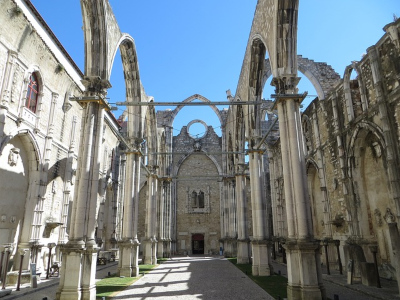The 1st of November 1755 should have been a festive day in Lisbon. To celebrate All Saints’ Day, many people attended the Latin mass. The city was decorated and candles were lit in every house. But all of a sudden, the earth began to shake. The walls started to tremble and then the roofs of the churches collapsed. The Feast of All Saints had turned into a catastrophe.

The Lisbon earthquake remains one of the greatest natural disasters to ever occur and has had a lasting impact on European philosophy and culture.
As far as we know today, the earthquake had a magnitude of 8.5 to 9 and lasted three to six minutes. The streets were destroyed by 5-metre-deep cracks and many buildings collapsed. To make matters even more serious, the candles in the houses and churches were knocked over, and suddenly a firestorm raged through the city. Most of the Lisbon inhabitants who survived ran to the docks, because there was nothing there that could collapse.
They couldn’t know it, but this was a fatal mistake. When they arrived, they discovered a strange phenomenon: all the water had vanished, revealing shipwrecks and treasures on the ground. But suddenly a huge wave formed in front of them: About 40 minutes after the earthquake, a tsunami flooded the city and the river.
Many people were unable to escape these disasters, which occurred so close together.
Throughout Europe, as far as Finland, the earthquake or its effects were felt, as well as in North Africa and even the Caribbean: a tsunami was reported, most likely connected to the Portuguese earthquake.
Once the ground had stopped shaking and the immediate threat of fire had been removed a few days later, the consequences began to become clear.
An estimated 40,000 to 50,000 people were killed in Portugal, Spain and Morocco – some researchers even assume that the figure is twice as high. As far as we know today, 85 % of the Lisboan buildings had been fallen victim to the earthquake such as the palace, the new opera and libraries and with them much famous art was irretrievably lost. The city, known for its wealth, trade and culture, was almost completely destroyed.
Many people had lost not only their homes and property, but also their friends and relatives. The army took action against looters and forced the citizens to stay in the city and start clearing the streets and rebuilding.
Impact on science and philosophy
Portugal received solidarity from many countries, including £100,000 of emergency aid from England. Within a month of the disaster, plans for reconstruction had been decided. The new buildings, named Pombaline, were to be earthquake-resistant – one of the first of their kind. The management of the disaster is now seen as an early beginning of organized crisis management and the scientific field of seismology. Much of the credit for this achievement goes to the prime minister, who took a scientific approach to analyzing the events. To get a clear picture of what had happened, he conducted questionnaires for the citizens – the answers have been archived until today. For reconstruction, he made use of the gained knowledge to prevent a possible similar catastrophe in future. Also, one of the first attempts was made to explain the earthquake scientifically: The famous philosopher Immanuel Kant developed some theories about its origin. Although they are far from the truth as we know it today, his attempt was an achievement for early seismology. Today we know that a thrust fault south-west of Cape St Vincent was probably the location and cause of the earthquake.
The Lisbon earthquake also had a major impact on philosophy during the Age of Enlightenment. It was during this time that the rational gain of knowledge and many ideas such as fundamental human rights were developed. The earthquake triggered a great philosophical debate: The philosopher Leibniz’s statement that we live in the best of all possible worlds was questioned. In the best of all possible worlds, how could such a catastrophe have happened? In his famous book Candide, the French philosopher Voltaire opposed Leibniz’s thesis: According to him, there is evil in the world that we humans cannot control. Rousseau, another French philosopher, thought that the earthquake showed that humans were the only ones responsible for evil in the world. Regarding the earthquake, he argued that people shouldn’t have lived in such a big city, but in a more natural way. The catastrophe made many people question the concept of optimism. Furthermore, it raised the theological question of theodicy.
Not only philosophers, but also musicians dealt with the traumatic events: The German composer Georg Philipp Telemann composed The Ode of Thunder in honour of the power of God, to commemorate the earthquake and to pray for the dead as well as the survivors.

Visitors to Lisbon nowadays can still see the effects of the earthquake. The Praça do Comércio, now a square, marks the site of the former palace, the wide streets and the beautiful Pombaline houses are the result of the rebuilding. But there is one building, the Carmo Convent, that has never been reconstructed – you will find it still in ruins, in memory of one of the greatest natural disasters and its victims.
References:
- https://en.wikipedia.org/wiki/1755_Lisbon_earthquake#Earthquake_and_tsunami
- https://de.wikipedia.org/wiki/Erdbeben_von_Lissabon_1755
- https://de.wikipedia.org/wiki/Donner-Ode
- The Wikipedia Community, Wikipedia, accessed 08/02/2023
- https://www.britannica.com/event/Lisbon-earthquake-of-1755 – The Editors of Encyclopaedia, Britannica, Encyclopaedia, Britannica, accessed 08/02/2023
- https://lisbonlisboaportugal.com/Lisbon-information/1755-lisbon-earthquake.html – LisbonLisboaPortugal.com, accessed 08/02/2023
- https://www.visitlisboa.com/en/places/praca-do-comercio-terreiro-do-paco – Turismo de Lisboa, accessed 08/02/2023

